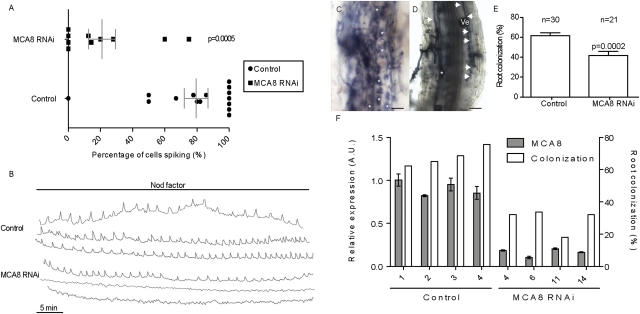Fig. 4.
Silencing MCA8 blocks Nod factor-induced calcium oscillations and reduces mycorrhizal colonization. (A) Scatterplot comparing the percentage of spiking root hair cells in control (empty vector) and MCA8 silenced roots. Each dot represents one transformed root plotted to indicate the percentage of cells on that root that showed calcium spiking upon Nod factor treatment. Only 20% of cells spiked in the silenced roots, compared with 80% in control vector transformed lines. The difference was significant (P value indicated in the graph). Shown in gray is the median for each construct with the SEM. (B) Representative traces from the analysis in A observed for the different constructs used. Of the cells responding with calcium spiking, MCA8 silenced roots showed some cells with calcium oscillations equivalent to the empty vector control. (C–F) Mycorrhization phenotype of MCA8 RNAi roots. (C) Fungal colonization of a control root; asterisks indicate arbuscules. (D) In MCA8 RNAi roots aberrant colonization can be observed: septate hyphae (arrowheads) and reduced number or absence of arbuscules (asterisk) and vesicles (Ve). (E) Average mycorrhizal colonization per construct; error bars are SEM. (F) Quantification of RNA levels in representative silencing lines compared with control lines, demonstrating efficient knockdown of MCA8. Also plotted is the colonization percentage of the roots assessed for MCA8 expression levels. (Scale bars in C and D, 0.1 mm.) A.U., arbitrary units.

